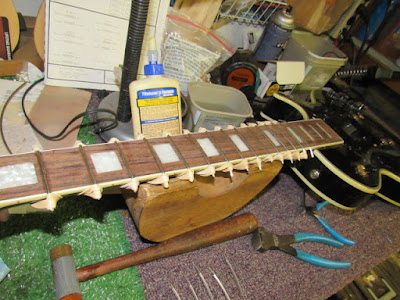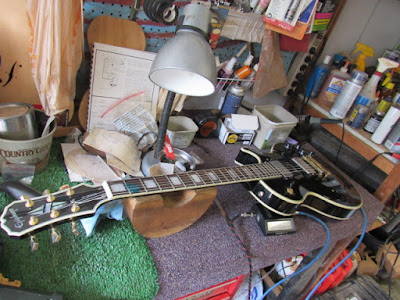I have always wanted a black Les Paul Custom. Of course, I know I can't afford a Gibson, but I am more than happy with an Epiphone. So when one popped up on Craigslist I had to take a peek. It turns out I had just bought a pickup from the seller of the Epiphone a few weeks before. He was selling the guitar along with an Epiphone hard-shell case for $275.
If you check Sweetwater you can see that an Epiphone Les Paul Custom now costs $679.00 new. The hard-shell case runs $129.00. So you can see why I jumped on this deal. When I checked out the guitar I saw why he was selling it so low. The frets were all ate up. Someone had played this guitar until the frets just didn't need fret-dressed, they needed replaced.
But that's okay since guitar repair is what I do. I'd not only re-fret the guitar, I'd buff out all the pick scratches, and change out the pickups. Here's what I was working with.
My camera isn't a high end camera, but I took a photo that tried to show the pick scratches.
First up, let's take a peek at those frets. My camera actually managed to get a someone decent photo of how chewed up they were.
Next I stripped the guitar of it's body hardware and removed the pickups.
Next it was time to remove the frets.
You can see just how roughed up the wood was. There were dips in the fretboard where it had been played heavily. So now it was time to use a radius block, and then a wood planer.
I radiused the fretboard until it was nice and smooth. I should also mention that before I started sanding I made sure the neck was completely flat. In other words, I adjusted the truss rod until it was nice and flat.
After I wiped the dust off here's what it looked like.
Not bad, huh? That looks 100 times better. Next up I used my tiny saw to clean out the fret slots. Since I had removed old frets and slung rosewood dust everywhere, the slots needed cleaned out. I took my time, and cleaned them until my tiny ruler measured the slots 4/32nds deep.
In the above photo you can see my small saw and ruler. In one of those, "Ounce of prevention/pound of cure," ideas, cleaning out the slots really helps in the long run. If there's not enough room for the tang to sit in the slot the fret just won't go in.
Next up I used my curling tool to curl up my fretwire. I decided on using "Dean" style guitar wire. In other words, it's taller and wider than most fretwire. That's okay since I am going to fret-dress it which brings down the overall height.
Next up, I cut the wire into individual frets. I used my tang-nipper to cut the inside tang to size. I usually work with three frets at a time.
Titebond 2 is my go-to glue of choice. I put glue in the slots, and hammered the frets in the old fashioned way. I like using rubber bands to hold them in.
We'll fast forward to where I installed a lot of frets.
Of course, the questions is, "What do I do when I can't reach a rubber band behind a fret? Simple. I grab my radius block and clamps. They'll put enough pressure to hold the frets down.
Now comes the part that a lot of people don't want to do. Letting the glue dry. That's right. I give the glue 48 hours to dry before I continue working on the guitar.
Next up I remove the clamps, block, and rubber bands. I use my fret cutters to cut the fret-ends.
Now I use a special angle file to even up the edges of the frets.
Next up I use a special triangle file to file the edges of the frets. Different luthiers will do this step in different places. I perform it here, and sometimes a second time after fret-dressing. Players really hate it when they cut their fingers while sliding on bar chords. I don't blame them.
This triangle file is special since the corners are smooth. That way I can file the frets in the way shown below.
A step that I've found to be very important is to use a marker and mark the top of the frets. That way, when I am performing a fret dress I can see where my file is cutting.
Now if I were doing this on a maple fretboard I would tape up everything but the frets. Since this is rosewood I am just going to buff the snot out of it anyway. Some luthiers would tape up the fingerboard no matter what kind of wood was used. It's really just personal preference.
Also, please notice the plastic sheet that I use to protect the body. This works great. It's much better than laying down 1000 feet of masking tape like I've seen some luthiers do.
My next step was to fret-dress the frets. I'd use my fret file to even out the frets. Once they were flat, I used my "high tech" block of wood to sand it down even finer. I attached coarse 80 grit sandpaper with duct tape, and ran it back and forth on the frets.
Next up, I used a 150 grit diamond fret file, and then a 300 grit diamond fret file. I should also mention that I use my straight-edges repeatedly throughout this step. I have to be sure that the frets are as perfectly straight as can be.
After that, I used my "high tech" homemade block of wood. This time I attached 120 grit sandpaper to my block of wood with duct tape. Again, I ran the block of wood back and forth to make sure the frets were perfectly even. Again, I am using my straight-edges throughout this step.
My next step used to be taking steel wool to the frets, but 3M has a new product that's much better and not as messy. They make these Scotch-bright pads that shine up the frets, but don't damage the wood. They also don't leave behind little pieces of steel wood that seem to magically attach themselves to your guitar pickups.
The gray one is equal to #00 steel wool, and the white one is equal to #0000 steel wool. See what a great job they do on the frets and fretboard?
The next step that I've found really makes a difference is using a buffer. Now I was going to use it anyway to buff out the guitar pick scratches, so this made it easy to just go over the entire guitar.
I used the three step buffing process, and it worked great.
After buffing the guitar out I checked the frets out with my straight-edges one last time. It measured perfectly flat. This would normally be the time where I would add some sort of oil to the fretboard. However, I kind of forgot this time around. So next time I change strings I will do that.
So next up was time to put the hardware back on, and install new pickups.
I decided to go with my favorite Schaller Golden 50 in the neck, and the Dean Leslie West, "Mountain of Tone" signature pickup in the bridge.
Once I installed them I had to set the guitar up. The big things to take care of were the string height, and adjusting/filing the nut slots. The intonation was perfect, and I only had to adjust the truss rod a little bit.
I have to say it feels good bring this guitar back to life. The "Mountain of Tone" pickup sounds a lot like a Seymour Duncan Custom 5. Which to me isn't that great. I never cared for the Custom 5, but this pickup sounds okay. I'll play it some, and see how I feel about it. But the lack of mids just make it seem like a weak pickup to me.
Next up I will be adding straplocks and a strap. Luckily I have some gold straplocks from years ago. I just never had a guitar to put them on until now. I'll end up playing this one for a while, and see how I feel about it. I'll see if I bond with it, or move it down the road. I will say I'm glad I had the chance to perform all this work on it. I think I enjoy working on them more than I do playing them these days.


















































